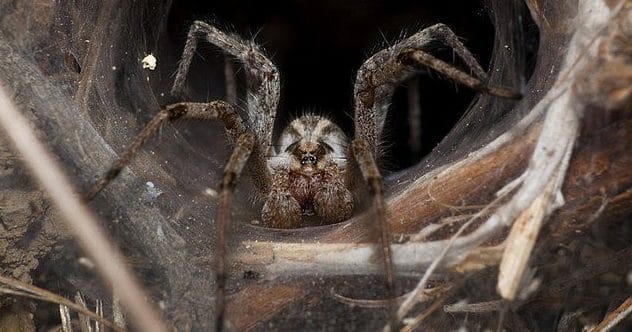10. Flies: The Unlikely Disease Detectives
Flies are often seen as pesky intruders, buzzing around and spreading germs. Nobody likes them near their food! But these common insects have a hidden talent. Believe it or not, fruit flies might be able to smell cancer in humans.
Scientists in Germany discovered this in 2014. They found that fruit flies have a very strong sense of smell that can pick up on cancer cells. Beyond detection, flies also help in cancer treatment research. Because they have short lives and body systems somewhat like ours, they are good for testing new treatments quickly and safely. This helps doctors find better ways to help patients.
9. Beetles: Ancient Healers, Modern Solutions
Beetles, with their incredible variety, are more than just crunchy snacks in some parts of the world. They have a long history in medicine. For ages, people have used different types of beetles to help with health problems. In traditional medicine, they were used to treat cysts, reduce fevers, and calm chills. Some were applied to the skin to stop itching from eczema.
Modern science has also found value in beetles. A substance called cantharidin, found in certain beetles, is quite special. While it didn’t get FDA approval many years ago due to limited information, doctors still use it. Dermatologists find cantharidin helpful for treating warts and other skin conditions. It’s a natural compound that’s hard to make in a lab, showing how unique these insects are.
8. Worms: Nature’s Tiny Surgeons and Suppliers
Though some find them off-putting, worms offer surprising health benefits. Earthworms, for example, are packed with nutrients like protein, iron, and calcium. Traditional cultures from China to Native American tribes have used earthworms for issues ranging from hair loss to joint pain.
Even silkworms, which are actually moth caterpillars, play a big role in medicine. Scientists in Japan cleverly modified silkworms to produce collagen. This collagen, which silkworms naturally make in small amounts for their cocoons, can be used to create artificial skin and bones, and even for cosmetic procedures. It’s amazing how these small creatures contribute to medical advances.
7. Termites: More Than Just Wood-Eaters
Finding termites in your house is usually bad news, but these tiny wood-chewers have a helpful side. Termites are eaten by people in many countries and are a good source of protein. Medicinally, they’re used in places like Brazil to treat asthma, flu, and bronchitis. In India, they’re used for ulcers and body pain, while Zambia uses them to help with child malnutrition.
Western scientists have also discovered powerful antimicrobial substances in termites. These natural compounds could fight bacteria and viruses that are resistant to other antibiotics. So, while they might damage homes, termites also offer potent healing properties.
6. Grasshoppers: A Superfood That Hops
Grasshoppers might not seem like a big deal, but they are actually a superfood! Some say they taste like shrimp. These hoppers are high in protein and healthy fats. Surprisingly, they have more antioxidants than fresh orange juice. They can also act as strong diuretics, which means they help your body get rid of extra water. This makes them useful for kidney and stomach problems.
Grasshoppers also contain a substance called chitin, which helps fight harmful bacteria. Plus, they are easy to digest and give you more energy than a bowl of cereal. Next time you think about a healthy snack, maybe a grasshopper isn’t such a wild idea after all!
5. Ants: Tiny Titans of Medicine
Ants are incredibly strong and numerous, and their medical uses are just as impressive. People have eaten ants for health benefits for a long time. Some even flavor alcohol with ants to use as medicine! But you don’t have to eat or drink them to benefit.
Different ants offer different perks. For instance, red wood ants produce formic acid to protect their nests. This acid can be used on the skin to treat ailments like warts. Leafcutter ants have special bacteria that fight off harmful fungus, and this bacteria is used to make powerful antifungal medicines. In traditional practices, ant heads were even used like stitches to close wounds. Scientists are still discovering new medical uses for these versatile insects.
4. Leeches: Bloodsuckers with Benefits
Leeches might give you the creeps, but they have a long and respected history in medicine. Leech therapy is still used today! The saliva of a leech contains a powerful substance called hirudin. Hirudin stops blood from clotting and helps reduce blood buildup in tissues.
Because of this special saliva, doctors use leeches in microsurgeries, like plastic surgery. They help prevent blood clots around tiny veins and cuts, which can prevent serious problems, even amputation. Leech saliva has also been used in medicines for high blood pressure, varicose veins, skin issues, and arthritis. It has even shown promise for patients with heart disease and cancer.
3. Spiders: Venom That Varies
Spiders often get a bad rap for being poisonous. While some are dangerous, many spiders have venom that’s more harmful to tiny insects than to humans. In fact, spider venom can have medical benefits. (Of course, this doesn’t apply to places like Australia with truly deadly spiders!)
Researchers have found that venom from spiders and scorpions can be used in medicines for everything from cancer to heart disease. Spider venom often targets the nervous system of its prey. Scientists learned that medicine made from this venom can work similarly in humans, making it useful for pain relief. Other types of spider venom contain a protein that stops muscle cells from breaking down. This could help treat diseases affecting muscles and movement.
2. Maggots: Tiny Clean-Up Crew
Maggots, the larvae of flies, might seem gross as they feast on decaying matter. However, some types of maggots have surprising medical uses. One of the first recorded uses was during World War I. Two soldiers were found after a week with wounds full of maggots. Doctors expected a terrible infection, but instead, the wounds were clean and uninfected.
After this discovery, maggots were used to treat wounds until the 1990s. Today, scientists are studying the chemicals maggots release as they clean dead tissue. They’ve found that these secretions can fight bacteria that are resistant to antibiotics. So, these tiny creatures play a vital role in healing.
1. Bees: The Ultimate Insect Healers
Bees are truly the superstars when it comes to life-saving insects. Their benefits are immense, starting with honey. Honey, made from flower nectar and special bee enzymes, is a superfood. It acts as an anti-inflammatory, antioxidant, and antibacterial agent. It’s commonly used to soothe coughs, sore throats, and to treat minor cuts and burns.
Beyond honey, bees themselves are crucial. They pollinate plants that provide us with food and oxygen. Even bee venom has medicinal uses. Apitherapy is a practice that uses bee venom to treat illnesses and reduce pain. It takes advantage of the anti-inflammatory properties in bee venom for conditions like rheumatoid arthritis and chronic pain. Bees are essential for our health and the planet.
It’s truly fascinating how nature works in mysterious ways. These ten creepy crawlies, often viewed with fear or disgust, show us that even the smallest creatures can offer monumental benefits to human health. From ancient remedies to cutting-edge scientific research, bugs are proving to be invaluable allies in our fight against diseases. Perhaps the next time you see a bug, you’ll remember its potential to heal.
Which of these insect healers surprised you the most? Do you know of any other bugs with medical uses? Share your thoughts and join the conversation in the comments below!










